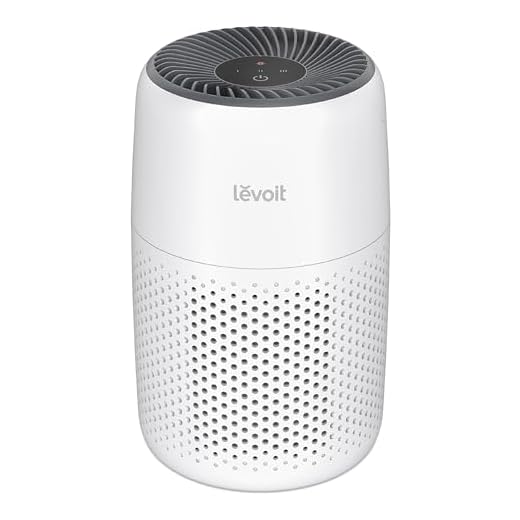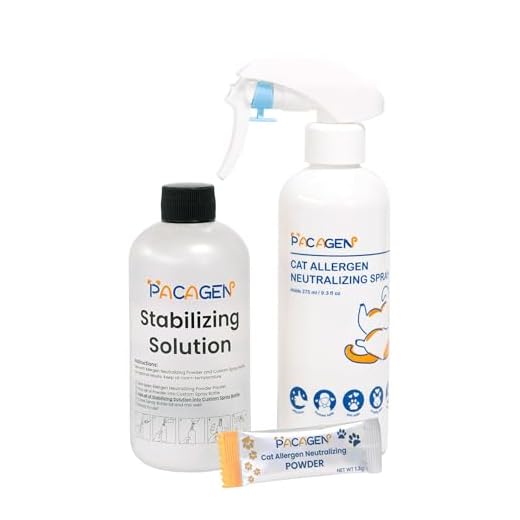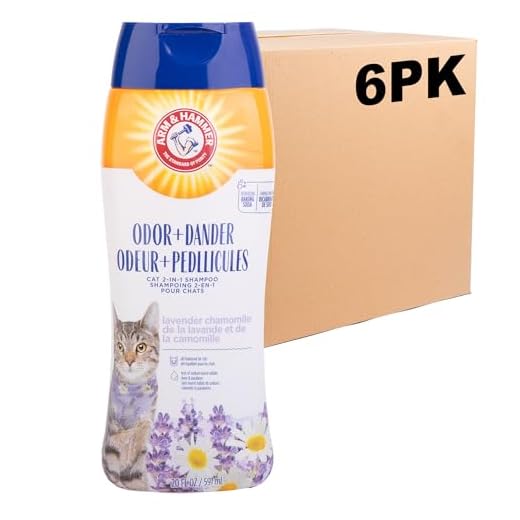



Living with a furry friend presents unique challenges for those sensitive to their presence. The first step is understanding the specific proteins responsible for reactions, primarily Fel d 1, found in cat saliva, skin, and urine. Reducing exposure is critical. Regular grooming of your pet can significantly decrease the amount of allergens in your home. Frequent bathing can also help, though it’s essential to consult a vet to ensure it’s done safely and comfortably.
Creating an allergen-reduced environment is another effective strategy. Utilizing HEPA filters in home air systems and vacuum cleaners can capture tiny particles, improving air quality. Designating certain areas of the house as pet-free zones also provides a safe haven for those with sensitivities. Daily cleaning and maintaining low humidity levels will further minimize allergens.
Gradual exposure may aid in decreasing sensitivity over time. Consulting with a healthcare provider about possible immunotherapy options could offer long-term relief. Staying informed and proactive in managing symptoms is key to enjoying life with a beloved feline companion.
Can You Build a Tolerance to Cat Allergies
Regular exposure to allergens over time might help some develop a reduced sensitivity. Gradually introducing small amounts of dander into the environment can lead to desensitization. This approach should be done cautiously and under professional supervision to avoid severe reactions.
Consider consulting an allergist who may suggest immunotherapy, a method that involves administering controlled doses of allergens to help the immune system adapt. This process can take several months to years, and results vary among individuals.
Maintaining a clean living space is crucial. Regular vacuuming with HEPA filters, using air purifiers, and bathing furry companions can significantly reduce allergen levels. If you’re dealing with lingering odors, check out whether will bleach kill cat urine smell for additional tips.
Monitoring symptoms closely during any exposure is essential. Keeping a record can help identify effective strategies for managing reactions and improving comfort levels.
Understanding the Mechanism of Allergy Tolerance
Research indicates that consistent exposure to allergens may lead to a significant reduction in sensitivity over time. For instance, regular encounters with proteins found in feline saliva, skin, and urine can promote a desensitizing effect. This process is often facilitated by the immune system’s adaptation, where it learns to recognize these proteins as less threatening.
Studies show that gradual exposure, akin to immunotherapy, can be beneficial. Individuals experiencing mild to moderate reactions might consider spending short periods in the presence of a feline companion, gradually increasing the duration of contact. This method may encourage the body to adjust its immune response, potentially leading to fewer symptoms.
Additionally, maintaining a clean environment plays a vital role. Regular cleaning of living spaces to minimize allergen accumulation is essential. Utilizing air purifiers and frequent washing of bedding can contribute to a healthier atmosphere, further supporting the body’s adjustment process.
Seeking advice from an allergist is recommended for tailored strategies. Medical professionals can provide insights into specific approaches, including possible allergy shots or other treatments that may facilitate a smoother adaptation to allergens.
In summary, consistent, controlled exposure combined with a clean environment and professional guidance can aid in reducing allergic reactions over time. Each individual may respond differently, so patience and observation are key components of this process.
Practical Steps to Reduce Allergy Symptoms Over Time
Regular cleaning is key. Vacuuming carpets, furniture, and curtains weekly helps eliminate allergens. Use a vacuum with a HEPA filter to trap tiny particles effectively.
Consider using air purifiers equipped with HEPA filters in rooms where I spend the most time. This can significantly reduce airborne irritants, creating a healthier environment.
Designate certain areas of the home as pet-free zones, especially bedrooms. This can reduce exposure during sleep, allowing for better rest.
Bathing me once a month can decrease dander levels. Use a gentle cat shampoo to avoid skin irritation and make sure to dry me thoroughly.
Regular grooming sessions can also help. Brush my fur outside to minimize the spread of allergens indoors. This keeps my coat healthy and reduces shedding.
Keep me up-to-date on my vaccinations and wellness checks. Healthy pets produce fewer allergens, so regular vet visits are vital.
Consider allergy testing from a veterinarian. Understanding specific triggers may lead to tailored strategies for managing symptoms effectively.
Implementing these practices consistently can lead to a more comfortable living situation over time, making it easier for everyone to coexist happily.
Living with a furry friend presents unique challenges for those sensitive to their presence. The first step is understanding the specific proteins responsible for reactions, primarily Fel d 1, found in cat saliva, skin, and urine. Reducing exposure is critical. Regular grooming of your pet can significantly decrease the amount of allergens in your home. Frequent bathing can also help, though it’s essential to consult a vet to ensure it’s done safely and comfortably.
Creating an allergen-reduced environment is another effective strategy. Utilizing HEPA filters in home air systems and vacuum cleaners can capture tiny particles, improving air quality. Designating certain areas of the house as pet-free zones also provides a safe haven for those with sensitivities. Daily cleaning and maintaining low humidity levels will further minimize allergens.
Gradual exposure may aid in decreasing sensitivity over time. Consulting with a healthcare provider about possible immunotherapy options could offer long-term relief. Staying informed and proactive in managing symptoms is key to enjoying life with a beloved feline companion.
Can You Build a Tolerance to Cat Allergies
Regular exposure to allergens over time might help some develop a reduced sensitivity. Gradually introducing small amounts of dander into the environment can lead to desensitization. This approach should be done cautiously and under professional supervision to avoid severe reactions.
Consider consulting an allergist who may suggest immunotherapy, a method that involves administering controlled doses of allergens to help the immune system adapt. This process can take several months to years, and results vary among individuals.
Maintaining a clean living space is crucial. Regular vacuuming with HEPA filters, using air purifiers, and bathing furry companions can significantly reduce allergen levels. If you’re dealing with lingering odors, check out whether will bleach kill cat urine smell for additional tips.
Monitoring symptoms closely during any exposure is essential. Keeping a record can help identify effective strategies for managing reactions and improving comfort levels.
Understanding the Mechanism of Allergy Tolerance
Research indicates that consistent exposure to allergens may lead to a significant reduction in sensitivity over time. For instance, regular encounters with proteins found in feline saliva, skin, and urine can promote a desensitizing effect. This process is often facilitated by the immune system’s adaptation, where it learns to recognize these proteins as less threatening.
Studies show that gradual exposure, akin to immunotherapy, can be beneficial. Individuals experiencing mild to moderate reactions might consider spending short periods in the presence of a feline companion, gradually increasing the duration of contact. This method may encourage the body to adjust its immune response, potentially leading to fewer symptoms.
Additionally, maintaining a clean environment plays a vital role. Regular cleaning of living spaces to minimize allergen accumulation is essential. Utilizing air purifiers and frequent washing of bedding can contribute to a healthier atmosphere, further supporting the body’s adjustment process.
Seeking advice from an allergist is recommended for tailored strategies. Medical professionals can provide insights into specific approaches, including possible allergy shots or other treatments that may facilitate a smoother adaptation to allergens.
In summary, consistent, controlled exposure combined with a clean environment and professional guidance can aid in reducing allergic reactions over time. Each individual may respond differently, so patience and observation are key components of this process.
Practical Steps to Reduce Allergy Symptoms Over Time
Regular cleaning is key. Vacuuming carpets, furniture, and curtains weekly helps eliminate allergens. Use a vacuum with a HEPA filter to trap tiny particles effectively.
Consider using air purifiers equipped with HEPA filters in rooms where I spend the most time. This can significantly reduce airborne irritants, creating a healthier environment.
Designate certain areas of the home as pet-free zones, especially bedrooms. This can reduce exposure during sleep, allowing for better rest.
Bathing me once a month can decrease dander levels. Use a gentle cat shampoo to avoid skin irritation and make sure to dry me thoroughly.
Regular grooming sessions can also help. Brush my fur outside to minimize the spread of allergens indoors. This keeps my coat healthy and reduces shedding.
Keep me up-to-date on my vaccinations and wellness checks. Healthy pets produce fewer allergens, so regular vet visits are vital.
Consider allergy testing from a veterinarian. Understanding specific triggers may lead to tailored strategies for managing symptoms effectively.
Implementing these practices consistently can lead to a more comfortable living situation over time, making it easier for everyone to coexist happily.
Living with a furry friend presents unique challenges for those sensitive to their presence. The first step is understanding the specific proteins responsible for reactions, primarily Fel d 1, found in cat saliva, skin, and urine. Reducing exposure is critical. Regular grooming of your pet can significantly decrease the amount of allergens in your home. Frequent bathing can also help, though it’s essential to consult a vet to ensure it’s done safely and comfortably.
Creating an allergen-reduced environment is another effective strategy. Utilizing HEPA filters in home air systems and vacuum cleaners can capture tiny particles, improving air quality. Designating certain areas of the house as pet-free zones also provides a safe haven for those with sensitivities. Daily cleaning and maintaining low humidity levels will further minimize allergens.
Gradual exposure may aid in decreasing sensitivity over time. Consulting with a healthcare provider about possible immunotherapy options could offer long-term relief. Staying informed and proactive in managing symptoms is key to enjoying life with a beloved feline companion.
Can You Build a Tolerance to Cat Allergies
Regular exposure to allergens over time might help some develop a reduced sensitivity. Gradually introducing small amounts of dander into the environment can lead to desensitization. This approach should be done cautiously and under professional supervision to avoid severe reactions.
Consider consulting an allergist who may suggest immunotherapy, a method that involves administering controlled doses of allergens to help the immune system adapt. This process can take several months to years, and results vary among individuals.
Maintaining a clean living space is crucial. Regular vacuuming with HEPA filters, using air purifiers, and bathing furry companions can significantly reduce allergen levels. If you’re dealing with lingering odors, check out whether will bleach kill cat urine smell for additional tips.
Monitoring symptoms closely during any exposure is essential. Keeping a record can help identify effective strategies for managing reactions and improving comfort levels.
Understanding the Mechanism of Allergy Tolerance
Research indicates that consistent exposure to allergens may lead to a significant reduction in sensitivity over time. For instance, regular encounters with proteins found in feline saliva, skin, and urine can promote a desensitizing effect. This process is often facilitated by the immune system’s adaptation, where it learns to recognize these proteins as less threatening.
Studies show that gradual exposure, akin to immunotherapy, can be beneficial. Individuals experiencing mild to moderate reactions might consider spending short periods in the presence of a feline companion, gradually increasing the duration of contact. This method may encourage the body to adjust its immune response, potentially leading to fewer symptoms.
Additionally, maintaining a clean environment plays a vital role. Regular cleaning of living spaces to minimize allergen accumulation is essential. Utilizing air purifiers and frequent washing of bedding can contribute to a healthier atmosphere, further supporting the body’s adjustment process.
Seeking advice from an allergist is recommended for tailored strategies. Medical professionals can provide insights into specific approaches, including possible allergy shots or other treatments that may facilitate a smoother adaptation to allergens.
In summary, consistent, controlled exposure combined with a clean environment and professional guidance can aid in reducing allergic reactions over time. Each individual may respond differently, so patience and observation are key components of this process.
Practical Steps to Reduce Allergy Symptoms Over Time
Regular cleaning is key. Vacuuming carpets, furniture, and curtains weekly helps eliminate allergens. Use a vacuum with a HEPA filter to trap tiny particles effectively.
Consider using air purifiers equipped with HEPA filters in rooms where I spend the most time. This can significantly reduce airborne irritants, creating a healthier environment.
Designate certain areas of the home as pet-free zones, especially bedrooms. This can reduce exposure during sleep, allowing for better rest.
Bathing me once a month can decrease dander levels. Use a gentle cat shampoo to avoid skin irritation and make sure to dry me thoroughly.
Regular grooming sessions can also help. Brush my fur outside to minimize the spread of allergens indoors. This keeps my coat healthy and reduces shedding.
Keep me up-to-date on my vaccinations and wellness checks. Healthy pets produce fewer allergens, so regular vet visits are vital.
Consider allergy testing from a veterinarian. Understanding specific triggers may lead to tailored strategies for managing symptoms effectively.
Implementing these practices consistently can lead to a more comfortable living situation over time, making it easier for everyone to coexist happily.











